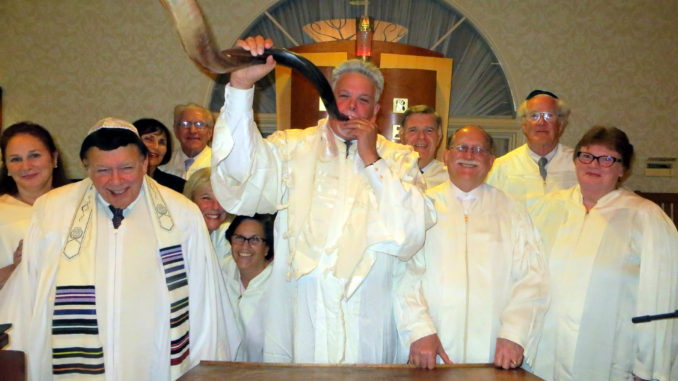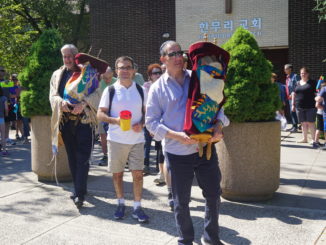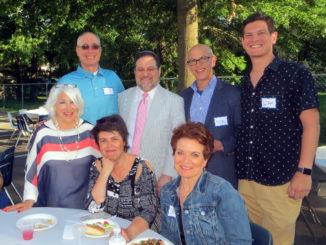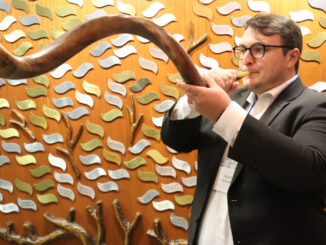
NORTHERN VALLEY AREA, N.J.—On the evening of Sept. 29, people around the world began the celebration of the Jewish New Year, known as Rosh Hashanah, the holiday that commemorates the creation of the world.
Beginning as far back as biblical times, Jews everywhere spend the Jewish New Year in the homes of friends and family and in synagogues carrying on the age old tradition referred to as “L’Dor-V’Dor,” “Generation to generation.”
In Hebrew, Rosh Hashanah means, literally, “head of the year” or “first of the year.”
Rosh Hashanah falls once a year during the month of Tishrei, the seventh month on the Hebrew calendar which takes place in early autumn in the Northern Hemisphere. Some traditions maintain that Rosh Hashanah starts on the anniversary of the creation of Adam and Eve.
In many congregations, Rosh Hashanah is celebrated on two successive days.
The Jewish New Year, one of the holiest observances in Judaism, is vastly different than the American New Year tradition of midnight partying. There is, however, one important similarity between the Jewish New Year and the American one—many Americans use the New Year as a time to make resolutions to break bad habits and begin a better lifestyle. Likewise, the Jewish New Year is a time when Jews begin introspection, looking back at mistakes and unfulfilled promises as well as planning the changes to make in the New Year.
The Jewish New Year begins with Rosh Hashanah, the time of repentance and of seeking reconciliation with people you have wronged and then concludes 10 days later, with the holiday of Yom Kippur. This 10 day period is commonly known as the Days of Awe (Yamim Noraim) or the Days of Repentance.
Jewish New Year traditions
The Jewish New Year is steeped in traditions. On the eve (Erev) of Rosh Hashanah, the New Year is heralded by the blowing of the Shofar in the synagogue. The Shofar is one of the earliest instruments used in Jewish music. It is usually made from a ram’s horn, but it can also be made from the horns of other animals, including those of a goat or sheep. It sounds somewhat like a trumpet, but unlike a trumpet, it does not have a mouthpiece.
So sacred is this tradition, that it is believed that even during the Holocaust, some Jews risked their lives by blowing a Shofar on Rosh Hashanah while imprisoned in Nazi concentration camps.
There are four different types of Shofar notes and a total of 100 notes are sounded each day. The Bible gives no specific reason for this practice, but it has been suggested that the Shofar’s sound is a call to repentance. In ancient times, the Shofar was a call to various disparate communities to make them aware of the holiday.
It is also traditional for Jewish families to gather for special meals to celebrate Rosh Hashanah. Over the centuries, this holiday has become associated with many food customs; for instance, eating sweet food like apples dipped in honey symbolizes people’s hopes for a “Sweet New Year.”
Many Jewish households also make honey cakes on Rosh Hashanah as another way to symbolically express their wishes for a sweet New Year.
Pomegranate, a fruit that contains 613 seeds, is also eaten on Rosh Hashanah. According to legend, the seeds symbolize the 613 “mitzvoth” (commandments) in the Bible and they also represent the plentiful good deeds in the coming year.
Challah bread, which is usually baked into braids, is shaped into round loaves of bread on Rosh Hashanah. The circular shape symbolizes the continuation of life.
Other popular foods eaten on the Jewish New Year include carrot stew and fish. The head of the fish symbolizes the “Head of the Year,” and also symbolizes God’s leadership.
No work is permitted on Rosh Hashanah. Much of the day is spent in synagogue, where the regular daily liturgy is somewhat expanded. In fact, there is a special prayer book called the “Machzor” that is used for Rosh Hashanah and Yom Kippur because of the extensive liturgical changes for these holidays.
One of the most important prayers of the New Year is Unetaneh Tohkef, a prayer about life and death. Part of it reads: “On Rosh HaShanah it is written, and on Yom Kippur it is sealed, how many will leave this world and how many will be born into it, who will live and who will die… But penitence, prayer and good deeds can annul the severity of the decree.”
Another popular practice of the holiday is Tashlikh (“casting off”). Jews walk to flowing water, such as a creek or river, on the afternoon of the first day of Rosh Hashanah, say a few prayers and empty their pockets into the river, symbolically casting off their sins. Small pieces of bread are commonly put in one’s pocket to cast off.
It is interesting to note that the Hebrew word for “sin” is “chet,” which is derived from an old archery term used when an archer “misses the mark.” It informs the Jewish view of sin: all people are essentially good, and sin is a product of our errors or missing the mark, as we are all imperfect.
The common greeting for the Jewish New Year is L’shanah Tovah, which means “May you be inscribed and sealed for a good year.”
For many people, including non-Jews, the Jewish New Year has personal as well as historical significance. Rabbi Steve Meltz of Chavurah Beth Shalom in Alpine believes that this is because “At Rosh Hashanah, when according to Jewish tradition time began, we celebrate the world and that part of God that resides within it, and within us all. We share this divine spark not just with other Jews, but with all humanity… for each of us is a creation of God and therefore, each of us is deserving of our respect. My wish is that the coming year brings peace to the entire human family in every part of the world.”
Rabbi David-Seth Kirshner, senior rabbi of Temple Emanu-El in Closter recently said, “The Jewish High Holidays is a season I take very seriously. For me, it is a gift in our tradition that affords me, and everyone, an opportunity to begin again, renewed and better educated with more experience than I had yesterday.
“When I was a kid and played any sport outside, sometimes when the ball would land on the roof, we got a do-over. This time of year is just that, a welcome do-over to make our relationships better and stronger, to learn from our mistakes and to be given an envelope to improve our three-way relationships: with God, with our neighbor and with ourselves.”



